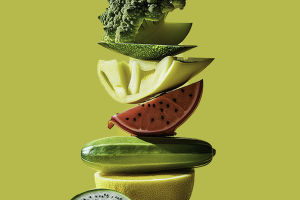
We all know that fruits and vegetables are crucial to a balanced diet. They are packed with vitamins, minerals, dietary fiber, and phytochemicals, which help improve our overall health.
These nutrients also play a key role in boosting our intake of micronutrients and phytochemicals, essential for our body's functions.
Evidence-based studies suggest that a diet rich in fruits and vegetables helps maintain a healthy body, prevents obesity, and reduces the risk of heart disease and lung cancer. They even have a protective effect against major digestive cancers like esophageal, stomach, and colon cancer. So, it's clear: eating plenty of fruits and vegetables is not just about filling up, it's about staying healthy!
Choosing Fresh Produce
The freshness of fruits and vegetables plays a big part in their nutritional value. Fresh, seasonal produce is typically vibrant in color, has high moisture content, and offers rich nutrients. These plants are still engaged in biological processes like respiration and maturation, which contribute to their health benefits.
For example, in spring, we can enjoy fresh vegetables like spring bamboo shoots, asparagus, leeks, spinach, and cabbage. Fruits like jujubes, loquats, mulberries, strawberries, and wax apples are also in season. When choosing produce, always look for the freshest options available!
Choosing by Color
The color of fruits and vegetables is a good indicator of the nutrients and phytochemicals they contain. Vegetables can generally be divided into two categories: dark-colored and light-colored. Dark vegetables, such as deep green, red, orange, and purple vegetables, tend to have a nutritional edge.
For example, they are often rich in beta-carotene, a major source of vitamin A. It's important to prioritize these in our diet, as they provide crucial vitamins for our health.
Examples of dark vegetables include spinach and rapeseed (green), carrots and tomatoes (orange), and purple cabbage and red amaranth (purple). Ideally, deep-colored vegetables should make up at least half of our daily vegetable intake. Mixing up the colors of our vegetables not only makes our plates more vibrant but also ensures we get a wide range of nutrients.
Varying Your Vegetables
With thousands of vegetable varieties to choose from, it's essential to switch things up and enjoy different types daily. Aim to include at least three to five different types of vegetables in your meals. This helps ensure that we get a broad spectrum of nutrients and plant compounds.
For example, root vegetables like potatoes and yams are higher in starch, while leafy greens and cruciferous vegetables like cabbage, broccoli, and kale are packed with dietary fiber and beneficial compounds like glucosinolates. Other vegetables like tomatoes, bell peppers, pumpkins, and eggplants are rich in vitamin C and carotenoids.
Don't forget legumes, such as broad beans, peas, and beans, which are popular in many dishes and are high in amino acids, minerals, and vitamins. Mushrooms and seaweed, such as shiitake, enoki mushrooms, and nori, are also rich in nutrients like vitamin B2, iron, selenium, and iodine.
Seasonal Fruits: A Must-Have
Fruits are just as diverse, and seasonality plays a big role in determining the sweetness and nutritional content of different fruits. Summer and fall are typically the best seasons for fruits, offering a wide variety of options. Aim to have at least one or two different fruits each day, focusing on those that are in season.
Each fruit brings its own unique sweetness and nutrient profile. For example, summer fruits like watermelon, peaches, and grapes are hydrating and rich in vitamins, while autumn fruits like apples, pears, and pomegranates are packed with antioxidants and fiber. Choose seasonal fruits whenever possible to enjoy the freshest and most nutritious options available.
Incorporating Variety into Your Diet
Choosing a variety of fruits and vegetables each day ensures we enjoy a wide range of nutrients, which contribute to overall health. Remember, no single fruit or vegetable can provide all the nutrients our bodies need, so diversifying our intake is key. By regularly switching up our choices and eating a rainbow of colors, we can ensure we're giving our bodies the best possible nutrition.
Lykkers, next time you're at the market, try thinking about variety and freshness. Your body will thank you!


